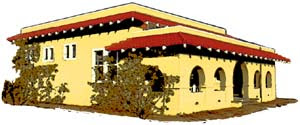By NEAL V. HITCH
Imperial Valley Press
Over the next year, the Imperial Valley Desert Museum will be fabricating and installing a permanent exhibit called the Land of Extremes. It will be an exhibit on the human adaptation to the desert environment.
That is just a big way of saying that it is really hard to live somewhere that is so hot and has so little water ... but people have been doing it for more than 10,000 years.
Telling this story, in fact, has been one of the primary objectives of the Imperial Valley Desert Museum Society since its incorporation in 1974. Over the summer, this story will unfold in a series of articles that will be included in the Saturday edition of the Imperial Valley Press.
The Imperial Valley Desert Museum has been a dream for more than four decades. The museum in Ocotillo opened in March 2012 after more than 13 years of construction. Since that time, more than 9,000 people have come out to Ocotillo for programs and activities. In December the museum became an approved curation facility for federal archaeology collections.
Soon, we will achieve the dream of being a fully functioning and operational visitor center welcoming thousands of visitors to the recreational and environmental opportunities of our deserts.
To many people in the county, this has been a long time coming, but success of finally getting the museum open owes to the grassroots organization behind the museum.
The Imperial Valley Desert Museum Society was incorporated in 1974 to support the “promotion and expansion” of the Imperial Valley College Desert Museum, which had been founded in 1969. Under the direction of Michael Barker and Jay von Werlhof, both anthropology professors at IVC, the college operated a small museum in downtown El Centro. The museum was ahead of its time for the Imperial Valley, with an outstanding archeology program run by the college and a Carbon 14 dating laboratory, one of just three in California.
But in 1979, the downtown building was destroyed in an earthquake. I am sure no one knew the path that lay ahead.
Von Werlhof came to teach at the IVC in 1973. When he arrived in the Valley, there were 109 recorded archaeological sites. Over the next several years, he documented more than 10,000 additional sites.
Under his direction, the Imperial Valley Desert Museum Society managed cultural and educational activities throughout the Valley. The main objectives were the preservation and investigation of cultural sites that pertained to early man. The society promoted the idea that Imperial County held “the key to the antiquity of man in the Western Hemisphere.”
Sometime around 1984, plans were drawn up and a fundraising campaign was initiated for a new Desert Museum. And in 1987, an Act of Congress transferred 24 acres of federal land in Ocotillo “for the purpose of constructing and maintaining a public museum.”
In the early 1990s work began at the site in Ocotillo. Everyone in the county thought that a new museum was right around the corner. But there was a long road of fundraising ahead. In 1999, a federal transportation enhancement grant, in the amount of $238,000, was received to put in a parking lot, trails and picnic shelters. “It Used to be a Dream,” the society announced. Fundraising continued. Family pledges were made at $2,000, with the donation paid annually over 10 years. People were asked to buy a square foot of the new museum for $55 ... 1,200 were sold.
During the 1990s, over $350,000 was raised locally, all in small gifts. It was decided that the building would be “built as income allows on a pay-as-you-go basis.”
In 2000, Duggins Construction erected the exterior of the museum. Not until 2005, did the society receive a large grant from the California Cultural and Historical Endowment to finish the interior of the building.
The Desert Museum’s primary focus since 2011 has been the inventory and re-curation of the IVC archaeological collection. This prehistoric artifact collection is one of the most significant collections in Southern California because it documents the life ways of the earliest people in our region. When von Werlhof led students into the desert, he taught that people began living here 10,000 to 12,000 years ago. In recent months, an archaeology site in Jacumba was positively dated to 8,400 BCE (Before the Common Era).
The story of how people adapted to living in such an extreme environment is exciting. It is a story that still affects those of us living in the Valley today. In the coming months the story will unfold at the Desert Museum as construction of exhibits gets underway. It is an exciting time at the museum. Finally, we can truly say it used to be a dream.
Neal V. Hitch is director of the Imperial Valley Desert Museum in Ocotillo.
IMPERIAL VALLEY DESERT MUSEUM
- 1969 – IVC establishes Department of Anthropology
- 1972 – H.P. Meyers Foundation donates building for Desert Museum
- 1973 – Jay von Werlhof hired by IVC
- 1974 – Imperial Valley Desert Museum Society incorporated as a 501(c)(3)
- 1979 – Museum building condemned owing to earthquake
- 1987 – By act of 100th Congress 25 acres set aside for museum in Ocotillo
- 1994 – Spirit of the Desert sculpture erected at the museum property
- 1995 – Groundbreaking ceremony at museum property
- 1999 – Caltrans ITEA grant awarded for access road, parking lot, picnic shelters, and landscaping
- 2000 – Duggins Construction builds exterior of museum building
- 2005 – CCHE grant awarded to finish interior of museum building
- 2008 – Certificate of Occupancy received from Imperial County
- 2012 – Museum staffed and opened to public
- 2013 – Inventory of IVC archaeology collection completed
- 2014 – Design of Permanent Exhibit completed





